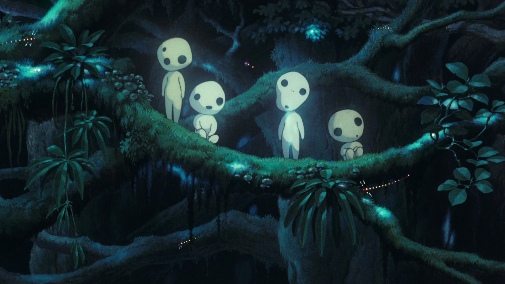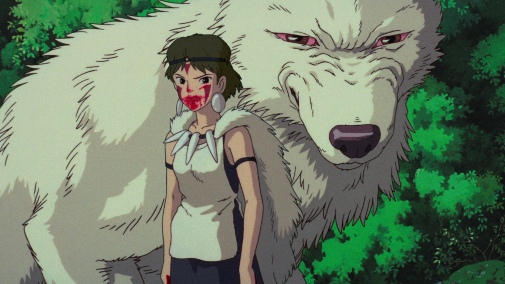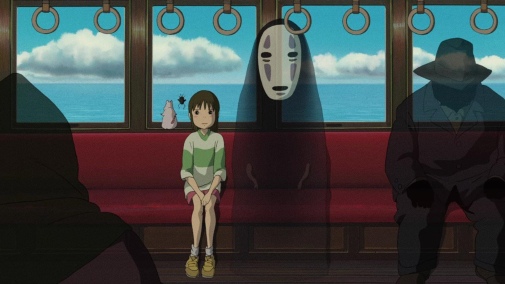My Miyazaki Ranking: Part Four – The Eternal Mystery
 Tuesday, March 26, 2024 at 6:00PM
Tuesday, March 26, 2024 at 6:00PM 
Exploring Hayao Miyazaki's filmography is to dive into a cinema that's often as moving as it is mysterious. Connections to the land abound, calling for ecological harmony in a place ravaged by modernity. Tradition dances with progress, teetering on the edge of oblivion, while dreams soar high above the clouds, for flight is the highest form of freedom. Even his most straightforward exercises tend to have an oneiric touch, some connection to the unknown within us and the world we inhabit. Because he taps into such (un)realities, Miyazaki's narrative work can move between genres and expectations, often complicating conflicts beyond the usual archetypes or doing away with them altogether. And through it all, animation allows the impossible to become possible, the screen a window to imagination unbound…

03. PRINCESS MONONOKE (1997)
The beginnings of Princess Mononoke can be traced to the 1970s when a young Hayao Miyazaki first envisioned the story of a young woman living with the wild beast-gods of ancient legend. The project, steeped in concepts from Japanese history since its genesis, was first envisioned for TV, but that version never came to fruition. During the 80s, Miyazaki published a book where remnants of unfinished projects had their time in the sun, including the rough draft of what would one day become Princess Mononoke. Later, in the 90s, after Studio Ghibli's foundation, a reprint of those illustrations led to the project's revival.
From the lead in a fairytale, the titular princess became a supporting character, while the figure of Ashitaka, a cursed prince from the Emishi People, would take the lead. As it developed, Princess Mononoke grew into an epic like nothing else Studio Ghibli had produced, a monument-sized tapestry where Miyazaki could explore some of the themes and ideas that had haunted him since time immemorial. Taking place before Japanese unification, the narrative considers the country before it was a nation, imagining the death rattle of a way of life inevitably perished at the hands of industry. Humanity needs Nature to survive in this vision, but they're also the land's greatest enemy, exploring its natural resources with unsustainable violence.
Porco Rosso might have considered military clashes, but it wasn't a war movie. Princess Mononoke, on the other hand, escalates into carnage, depicting the conflict between two furious factions, neither of which is entirely right or wrong. But rather than what happens in many such stories, the hatred germinating in their fight isn't a source of power. Instead, it festers into a sickness. It changes those affected and makes monsters of us all. Never before had Ghibli touched upon such apocalyptic portent - somehow, even Nausicaä seems more optimistic - but the most lasting impact lies in the lack of a solution. Though total disaster is averted by the tale's end, there remains a sense that the conflict is far from over.
We know that the harmony some characters hope for will never come to pass. Their present is our past, and our present is the aftermath of their fateful tragedy. The scant sense of triumph at the end of Princess Mononoke, the exhausted sigh of relief shared between screen and viewer, is naught but a pyrrhic victory. It's hollow. But that doesn't mean, Miyazaki has succumbed to despair, or that his film is a black hole where the will to live goes to die. Humanism perseveres in the darkness, and even the putative villains have more dimensions than we might expect. When declaring this movie as animation aimed at adult audiences, folks sometimes get too caught up in the blood and rotting flesh. More than the gore, its ideas are the source of maturity.
Above violence, tonal solemnity rules Princess Mononoke, with everything, from epic imagery to the soundtrack's constant lament, contributing to that feeling. Moreover, we finish the adventure without the sense that we've uncovered all its secrets. Some things remain hidden in the animated woods, mysticism beyond our reach even as the credits roll and bid us farewell. An unnerving sense persists that what's depicted on screen is only a fraction of something bigger than the human mind can conceive. Something older and more immense than the relative smallness of Man. Such is Nature, especially when seen through Miyazaki's gaze.
The film is also visceral in material terms nearly unique within the Ghibli canon, the fantasy always based on physical bodies rather than some airy dream. Miyazaki made sure of that, supervising every single frame personally. It was also the first significant use of 3-D rendering in the director's oeuvre, manifest in the leech-like pulsations of Ashitaka's malady. The scale of the endeavor was enough to exhaust the artist, then in his mid-50s, prompting the first of many retirement announcements. Even when he returned to work on more films, none would be made like this mythic feature, so intensely supervised by one sole individual. Princess Mononoke thus marks the last production of its kind, the end of an era.

02. SPIRITED AWAY (2001)
Ghibli legend says Hayao Miyazaki was enjoying his retirement post-Princess Mononoke when an idea struck. He had been staying with friends – producer Seiji Okuda and his wife - inevitably spending time in the company of their pre-teen daughter. The experience made him realize that, in all his films, he'd never made one concerning that specific phase of a young person's life, the limbo between childhood and adolescence. Miyazaki also concluded that the current media landscape had little to offer to such people - the age group was done wrong and deserved better. And so, he quietly started working on what would become Spirited Away, constructing the concept around a character around the girl that inspired his latest venture.
That's not to say that the film is a commonplace coming-of-age story. Young Chihiro experiences much across her misadventure, discovering new responsibilities, learning to adapt to many obstacles, and becoming more mature, even more spiritual, as she traverses the barriers between worlds. That last part is essential, for Spirited Away is something of a Japanese Alice in Wonderland, starting with the little girl traversing into another realm and going from there, sinking deeper into the mysterious nowhere before she can find her way back home. In some ways, the heroine's voyage is also her director's since he was also walking forward with little notion of where he'd end up.
If you've read some of Miyazaki's many interviews or watched the documentaries about him, you might have come face to face with his methodological paradox. On one hand, the man's process is exacting to the extreme. On the other hand, it's wildly intuitive. These contradictory impulses make sense in the narratively loose yet precisely animated worlds the artist conjures, but they do sow chaos over the filmmaking part of the business. Consider that Miyazaki writes by storyboarding, with the pictures starting production long before he's reached the end of whatever he's creating. Animators may be drawing concepts they don't quite comprehend, and even the man in charge remains unaware of his movie's final shape until everything is said and done.
In the case of Spirited Away, Miyazaki has stated he had little idea of what he was doing, letting himself be carried away by the story. Some other studios and directors would be fated to make garbage under such circumstances. But Ghibli and its flight-obsessed founder manage to avoid the pitfalls, ending up with a miracle of cinema, animation taken to the highest degree of perfection, so beautiful it makes your heart contract in terrified awe. A pageantry of spirits here and illogical architecture there, a celebration of Japanese folklore intermingle with new creations like a No-Face whose meaning shifts. Some more bird shenanigans will manifest at times, and an ecological parable runs through every nightmare.
Rivers are dragons, desperate yet kind, but also people seeking freedom from a witch's hold and Humanity's pollution. When you think you can't tolerate any more grotesquerie, something ravishing will emerge, a flurry of flowers, or the salvation of a remembered name. While pummeled by the story's many turns, the audience is never abandoned, for Miyazaki is bubbling with grace and generosity at each turn. The world might be cruel, and there is much cruelty in the story, but the film shall never seek to hurt beyond repair. Everything, everywhere, all at once – such is the wonders brought to life in Spirited Away, a film that defies description, every rambled praise insufficient to honor its majesty.
![]()
01. MY NEIGHBOR TOTORO (1988)
After trying – perchance failing – to describe the enormity of Princess Mononoke and Spirited Away, there's something quaint about returning to the basics. And indeed, there's no simpler or shorter feature in Miyazaki's career than My Neighbor Totoro, released in 1988 in an ill-advised double bill with Isao Takahata's Grave of the Fireflies. The plot is barebones, to say the least, more of a summery observation than a story proper. Characters are modest, drawn from life - including the director's nieces - and the design obeys natural rules of light and color, nothing too extreme or outré. There's none of Castle Cagliostro's slapstick, the fantastic architecture of Castle in the Sky, or the megafauna of Nausicaä.
Well, there is Totoro himself and the Kittenbus, but they aren't in the same league as the giant bugs inhabiting the wasteland bordering the Valley of the Wind. If anything, they sacrifice design complexity for expressive grace, just a few lines articulating shapes that appeal to our soft hearts and love for cutesiness. Please don't interpret such words as my dismissal. These creatures are glorious bits of animation, each gesture considered for maximum humor, calibrated to awaken our compassion and comfort. They're lovely in ways I can scarcely put into words. Just think of Totoro's rainy interlude, discovering the wonders of ASMR as drops sing a drumming tune when they fall on the monster's borrowed umbrella. It's pure bliss.
That relative simplicity is part of why Studio Ghibli managed to divide itself into two, splitting the team between the co-founders' simultaneous, tonally opposite projects. But again, one shouldn't think that what's simple is easy or meritless. Each frame in My Neighbor Totoro is pondered, as elegant as anything in Miyazaki's sprawling canon, with something as minor as the color of the soil chosen explicitly by the filmmakers to evoke certain parts of Japan's geography. Indeed, this is an intrinsically Japanese tale, bringing folk superstition to a time and place that seems to exist out of history. It's modern and isn't, a spell of nostalgia like the kiss of sunlight on a warm summer afternoon.
Going beyond the creatures that enchant the viewers, one should also appreciate the animation of the people in My Neighbor Totoro. The little sisters at the story's center are brilliant characterizations, their varying motions giving us an insight into how they approach their surroundings and respond to the wonderland critters nearby. There's a moment when the youngest sibling, Mei Mei, brings flowers to her father's desk, which has stayed with me ever since I first saw the film. Kindness exudes from the screen, glowing a phosphene embrace that can make anyone fall back into childhood memories. Joy is given filmic form in My Neighbor Totoro, synthetized like never before or since.
However, one shouldn't approach the film thinking there's just merriment in store. Part of its genius comes from the frankness with which it approaches grief from a kid's perspective, drawing from the director's youth with a sickly mother whose potential loss was an ever-present concern. It's absurd to say so, but My Neighbor Totoro taps into emotional realism like few family movies in the medium's history, reaching for the truth in our hearts through an appeal to the impossible. Grounded storytelling holds hands with the eternal mystery, and so cinema strides into our souls. It makes a home there and fills the place with magic. Drunk in wonder, it almost feels like we can fly.
These three cinematic miracles are all streaming on Max. You can also rent or purchase them on most major platforms.



Reader Comments (2)
Loved, loved and loved this series.
My ranking would go:
1) Spirtied Away
2) Princess Mononoke
3) Howl
4) Ponyo (I always amuse myself to have this one so high)
5) The Boy and the heron
6) The Castle in the sky
7) Totoro
8) Porco Rosso
9) Nausicaa
10) The wind rises
11) Kiki
But could change, they're all beautiful movies
I feel it's impossible to rank Miyazaki's films by quality because they're all masterpieces, so I just rank them by personal preference. My rankings may be quite different from others though.
12. Howl's Moving Castle
11. Nausicaa of the Valley of the Wind
10. The Wind Rises
9. The Castle of Cagliostro
8. Princess Mononoke
7. Porco Rosso
6. Ponyo
5. The Boy and the Heron
4. Kiki's Delivery Service
3. Castle in the Sky
2. My Neighbor Totoro
1. Spirited Away